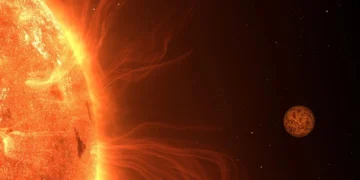The James Webb Space Telescope (JWST) continues to reshape our understanding of the cosmos, and its latest findings about TRAPPIST-1b—one of seven rocky planets orbiting the nearby red dwarf TRAPPIST-1—have reignited discussions in exoplanet research.
The Unique TRAPPIST-1 System
TRAPPIST-1, discovered in 2017, is one of the most remarkable planetary systems in our galaxy. It consists of seven Earth-sized rocky planets orbiting a dim, cool red dwarf star only 39 light-years from Earth. What makes this system extraordinary is that three of its planets are in the star’s habitable zone, where liquid water could potentially exist. TRAPPIST-1b, the innermost planet, lies too close to its star to be habitable.
Its proximity results in extreme stellar radiation, which could strip away any atmosphere it might have. However, its significance lies in its potential to help scientists understand the dynamics of exoplanet atmospheres—particularly those around red dwarfs, which are the most common type of star in the universe.
JWST’s Cutting-Edge Observations of TRAPPIST-1b
The JWST observed TRAPPIST-1b using mid-infrared thermal emission measurements, focusing on two key wavelengths: 15 microns and 12.8 microns. These wavelengths are crucial for identifying heat signatures and atmospheric components. The telescope used a technique called occultation, which measures the drop in light as the planet passes behind its host star.
This method allowed researchers to separate the planet’s heat signature from the star’s light. The results were intriguing. The earlier 15-micron measurements suggested a “dark bare rock” scenario, where the planet lacks an atmosphere and has a surface that absorbs nearly all the starlight. However, the new 12.8-micron data introduced a second possibility: TRAPPIST-1b might have a thin, CO₂-rich atmosphere with haze. This dual scenario highlights the challenges and breakthroughs in exoplanet research.
Bare Rock or Hazy Atmosphere? Decoding TRAPPIST-1b
Scenario 1: A Bare Volcanic Rock
TRAPPIST-1b could be a bare rock, similar to Mercury in our solar system. If it has no atmosphere, its surface might consist of ultramafic volcanic rocks, rich in magnesium and iron. These rocks could explain the planet’s strong heat signature, as they absorb and re-radiate stellar energy efficiently. Such a surface would also indicate intense geological activity, possibly driven by tidal heating from the star’s gravity.
This scenario is consistent with the planet’s extreme proximity to its host star, where atmospheric loss is likely due to intense stellar radiation.
Scenario 2: A Hazy Atmosphere
The alternative scenario suggests that TRAPPIST-1b might host a thin atmosphere rich in CO₂ and haze. The presence of haze could create a thermal inversion, where the upper atmosphere is warmer than the lower layers. This phenomenon occurs when haze absorbs starlight, heating the upper atmosphere and causing CO₂ to emit radiation instead of absorbing it.
Similar thermal inversions are seen in our solar system, such as on Saturn’s moon Titan. While this atmospheric model is less likely than the bare rock scenario, it opens the door to fascinating possibilities.
The Challenges of Exoplanet Atmosphere Studies
Studying the atmospheres of exoplanets, especially those around red dwarfs, presents unique challenges. Red dwarfs are known for their stellar activity, including flares and surface inhomogeneity, which can contaminate observations.
These factors make it difficult to disentangle planetary signals from stellar noise. JWST addresses these challenges with advanced techniques like emission spectroscopy and occultation measurements. However, even with these tools, relying on data from limited wavelengths can lead to uncertainties. For TRAPPIST-1b, more comprehensive observations across a broader spectrum are needed to confirm its atmospheric status.
Implications for Exoplanet Research
The findings about TRAPPIST-1b have broader implications for exoplanet science. If it is a bare rock, it provides a baseline for understanding planetary surfaces in extreme environments. If it has a hazy atmosphere, it could redefine our understanding of atmospheric retention and chemistry around red dwarfs.
Moreover, TRAPPIST-1b serves as a testing ground for methods that will be applied to other exoplanets, including those in the habitable zones of stars. By refining techniques and models, scientists can better assess the potential for life on distant worlds.
The Next Steps: Unlocking TRAPPIST-1b’s Mysteries
Future observations of TRAPPIST-1b, including phase curve analysis, will provide more clues about its atmospheric or surface properties. By studying how heat is distributed across the planet, researchers can determine whether it has an atmosphere.
A planet with an atmosphere would show heat transfer from the day side to the night side, while a bare rock would have minimal heat redistribution. Additionally, advanced 3D modeling and observations at other wavelengths will help resolve the current uncertainties. The upcoming “Rocky Worlds” program, which allocates 500 hours of JWST observation time to studying rocky exoplanets, will play a crucial role in this research.
Why TRAPPIST-1b Matters
The study of TRAPPIST-1b is not just about one planet—it’s about understanding the diversity of planetary systems and the potential for life beyond Earth. By unraveling the mysteries of TRAPPIST-1b, scientists gain insights into the processes that shape rocky planets, atmospheres, and habitability. These findings also pave the way for future exploration of planets in the habitable zones of TRAPPIST-1 and other systems.
Reference:



















